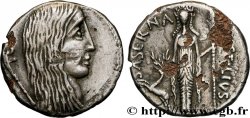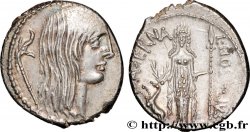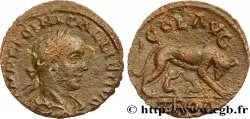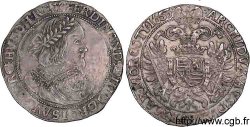v52_0357 - HOSTILIA Denier
MONNAIES 52 (2012)
Precio de inicio : 1 200.00 €
Valoración : 2 400.00 €
Precio realizado : 2 369.00 €
Número de ofertas : 3
Oferta más alta : 4 500.00 €
Precio de inicio : 1 200.00 €
Valoración : 2 400.00 €
Precio realizado : 2 369.00 €
Número de ofertas : 3
Oferta más alta : 4 500.00 €
Tipo : Denier
Fecha: 48 AC.
Nombre del taller / ciudad: Roma
Metal: plata
Milésimas de pureza : 950 ‰
Diámetro: 17,5 mm
Eje de acuñación: 12 h.
Peso: 3,82 g.
Grado de rareza: R2
Comentarios sobre el estado de conservación:
Exemplaire sur un petit flan bien centré des deux côtés, un peu court sur la légende du revers à l’exergue. Beau portrait de Vercingétorix, bien venu à la frappe, la chevelure mise en valeur par la patine. Revers de style fin à l’usure superficielle. Patine grise de collection ancienne avec des reflets mordorés
N° en los catálogos de referencia :
Pedigrí:
Cet exemplaire a été acquis auprès d’Alain Weil en mai 1999 et de la collection D. C
Anverso
Titulatura del anverso: ANÉPIGRAPHE.
Descripción del anverso: Tête barbue de guerrier gaulois à droite (Vercingétorix) ; derrière, un bouclier gaulois.
Reverso
Titulatura del reverso: L HOSTILIVS/ SASERN.
Descripción del reverso: Guerrier combattant dans un bige galopant à droite, conduit par un aurige, tenant les rênes de la main droite et un fouet de la main gauche ; le guerrier, nu est tourné à gauche, brandissant une javeline de la main droite et tenant un bouclier de la main gauche.
Traducción del reverso: “Lucius Hostilius Saserna”, (Lucius Hostilius Saserna).
Comentario
Pour ce type, M. Crawford a relevé une estimation de 57 coins de droit et de 63 coins de revers. Ce type, très populaire et recherché semble plus rare dans les trésors. Seulement dix-neuf exemplaires ont été relevés par M. Crawford. C’est le plus gaulois des deniers romains ou le plus romain des guerriers gaulois. La tête échevelée et barbue n’a rien à voir avec le buste élégant et hellénisant des statères arvernes épigraphes de Vercingétorix (LT. 3774-3778). Néanmoins, dans de nombreux ouvrages d’histoire ou de latin, c’est le visage du vaincu qui a été retenu, pour illustrer le chef gaulois, pour nous représenter l’image du chef battu par César qui devait être peu âgé et à demi-barbare afin de symboliser le combat de titan qui avait opposé les deux hommes dans la dernière phase de la Guerre des Gaules. N’oublions pas, au contraire, que le chef gaulois était âgé d’une vingtaine d’années quand il souleva la Gaule contre l’envahisseur et, n’en n’avait pas trente quand il fut étranglé dans sa prison à Rome. Encore une fois, c’est un acteur direct de la Guerre des Gaules, Lucius Hostilius Saserna, collaborateur de J. César, qui a fait frapper ce denier, deux ans avant le quadruple Triomphe de son ami et mentor.
For this guy, M. Crawford noted an estimate of 57 obverse dies and 63 reverse dies. This type, very popular and sought after, seems rarer in treasures. Only nineteen examples were noted by M.. Crawford. He is the most Gallic of Roman denarii or the most Roman of Gallic warriors.. The disheveled and bearded head has nothing to do with the elegant and Hellenistic bust of the Arverni epigraph staters of Vercingetorix (LT. 3774-3778). However, in many works of history or Latin, it is the face of the vanquished that has been chosen to illustrate the Gallic leader, to represent to us the image of the leader beaten by Caesar who must have been relatively old and half-barbarian in order to symbolize the titanic combat that opposed the two men in the last phase of the Gallic Wars.. Let us not forget, on the contrary, that the Gallic leader was about twenty years old when he raised Gaul against the invader and was not yet thirty when he was strangled in his prison in Rome.. Once again, it is a direct actor in the Gallic Wars, Lucius Hostilius Saserna, collaborator of J. Caesar, who had this denarius struck, two years before the quadruple Triumph of his friend and mentor
For this guy, M. Crawford noted an estimate of 57 obverse dies and 63 reverse dies. This type, very popular and sought after, seems rarer in treasures. Only nineteen examples were noted by M.. Crawford. He is the most Gallic of Roman denarii or the most Roman of Gallic warriors.. The disheveled and bearded head has nothing to do with the elegant and Hellenistic bust of the Arverni epigraph staters of Vercingetorix (LT. 3774-3778). However, in many works of history or Latin, it is the face of the vanquished that has been chosen to illustrate the Gallic leader, to represent to us the image of the leader beaten by Caesar who must have been relatively old and half-barbarian in order to symbolize the titanic combat that opposed the two men in the last phase of the Gallic Wars.. Let us not forget, on the contrary, that the Gallic leader was about twenty years old when he raised Gaul against the invader and was not yet thirty when he was strangled in his prison in Rome.. Once again, it is a direct actor in the Gallic Wars, Lucius Hostilius Saserna, collaborator of J. Caesar, who had this denarius struck, two years before the quadruple Triumph of his friend and mentor








 Informar de un error
Informar de un error Imprimir la página
Imprimir la página Comparte mi selección
Comparte mi selección Haz una pregunta
Haz una pregunta Consignar / vender
Consignar / vender
 Descriptivo
Descriptivo













